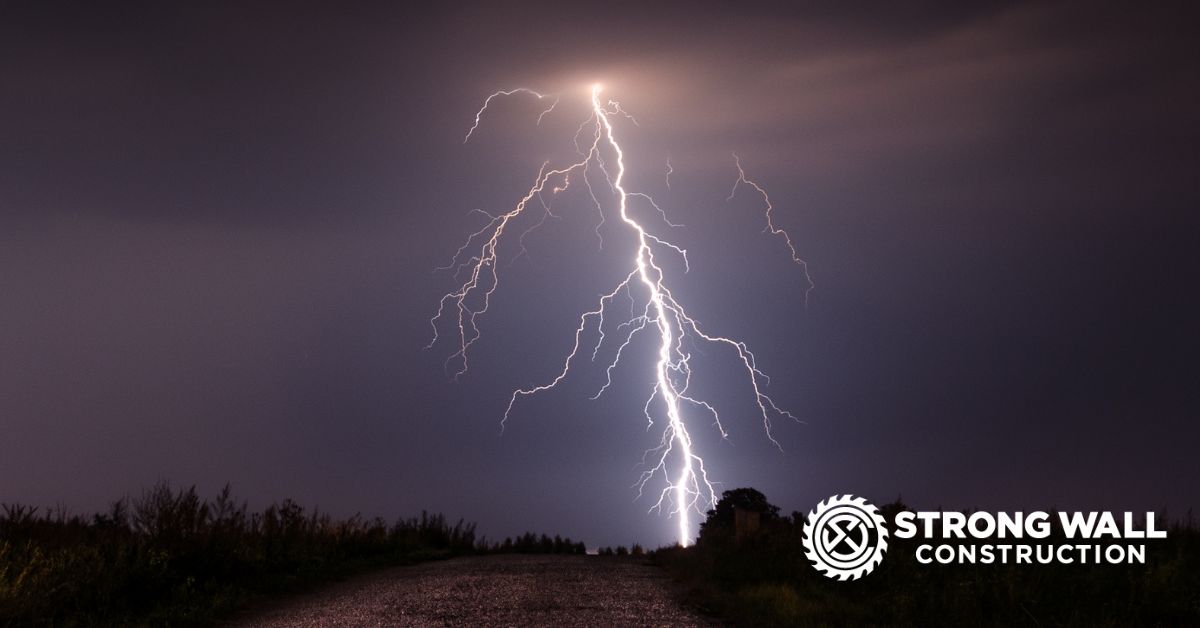As spring ushers in its mild breezes and budding blooms, it also brings with it…

Severe Thunderstorm Warning? 10 Tips for Storm Preparedness & Safety
The days are growing longer and warmer – spring and summer are officially upon us. Despite the beauty of these seasons, we also have to contend with severe thunderstorms and unpredictable weather. It’s critical to be prepared and informed about storm safety.
This blog will provide storm safety tips to help you navigate unpredictable weather, keeping your home and yourself safe. Storms are a natural part of the changing seasons, and with the proper knowledge and precautions, we can enjoy nature while staying safe and secure. So let’s dive into these vital storm safety tips!
1. Pay Attention to Severe Thunderstorm Warnings
Monitor local weather reports and pay attention to severe thunderstorm warnings. It’s critical to stay informed – warnings mean severe weather is right around the corner, and if necessary, you must act quickly to ensure your safety.
2. Know the Difference Between a Thunderstorm Watch and Warning
On that note, knowing the difference between a severe thunderstorm watch and a warning is essential. A thunderstorm watch means that weather conditions are just right for a severe thunderstorm to develop, while a warning means that a severe thunderstorm is happening or about to happen.
If there’s a thunderstorm watch, be on the lookout, and regularly check for updates – consider heading home if you’re outdoors. If there’s a warning, take more immediate action to protect yourself.
3. Prepare Against Windstorm Damage
Thunderstorms happen more frequently during the spring and summer, so it’s the perfect time of year to prepare for damage. Trim trees and remove dead branches around your home to guard against windstorm damage.
Additionally, secure outdoor furniture, decorations, and any loose objects – strong winds will turn these things into projectiles that could pose a severe threat.
4. Consider Installing Storm Shutters
If your location experiences severe thunderstorms, consider installing storm shutters on your windows to provide window protection against strong winds and flying debris. These shutters help withstand extreme weather conditions and can keep your home protected.
5. Sandbag Your Doorways
Flooding and water damage is a serious threat during severe thunderstorms. You can place sandbags around your doorways to help protect your home from flooding during severe weather. They work by creating a barrier that helps redirect and absorb water, sending the water away from your home’s foundation.
6. Practice Lightning Safety
When indoors during a thunderstorm, stay away from windows, doors, and electrical appliances. If possible, unplug electrical devices to protect them from power surges caused by lightning. You should also avoid taking showers or baths as water conducts electricity.
7. Stay Away from Water
Avoid bodies of water such as lakes, ponds, pools, and rivers during thunderstorms. As we said before, water conducts electricity, and lightning can strike the water’s surface anytime.
8. Wait Indoors
After a thunderstorm has passed, wait at least 30 minutes from when you stop hearing thunder or seeing lightning before going outside. Lightning can still pose a threat, even after a storm has moved on.
9. Avoid Open Areas
If you’re outdoors when a thunderstorm strikes, try to get inside as soon as possible. If you can’t get home or inside a building, seek shelter in a vehicle. Avoid open fields, hilltops, and tall structures that could attract lightning.
10. Practice Storm Preparedness
Be proactive and have a plan in place for storm preparedness. Create an emergency kit with essential supplies like food, water, flashlights, batteries, a first aid kit, and a battery-powered radio.
Educate yourself and your family on severe weather safety protocols. Establish a designated safe area in your home, such as a basement or interior room without windows, where you can take shelter during severe thunderstorm warnings.
Paying attention to severe thunderstorm warnings and staying informed about changing weather conditions is crucial. By being proactive and prepared, you can ensure the safety of yourself and your loved ones during severe thunderstorms.
And, if you find yourself in the aftermath of severe thunderstorm damage, we have additional tips on protecting yourself from stormchasers – contractors who prey on homeowners in difficult situations – and how to clean up after a storm.
Navigating Storm Damage with Strong Wall Construction
When severe thunderstorms strike, the damage to your home can be overwhelming, and that’s where Strong Wall Construction comes in. With years of expertise in storm damage restoration, our dedicated team is here to provide reliable solutions to restore your home to prime condition.
Securing your property, preventing further damage, and assessing the extent of storm damage – we’ll be with you every step of the way. We understand the urgency of storm damage situations and provide quick and effective restoration solutions to prevent further damage. You can trust we’ll prioritize your safety and peace of mind.
We’re committed to delivering exceptional results and ensuring your complete satisfaction at Strong Wall Construction. We’re here to support you in your time of need and help you rebuild after severe thunderstorms. You can learn more about the Strong Wall difference by talking to an expert today.



